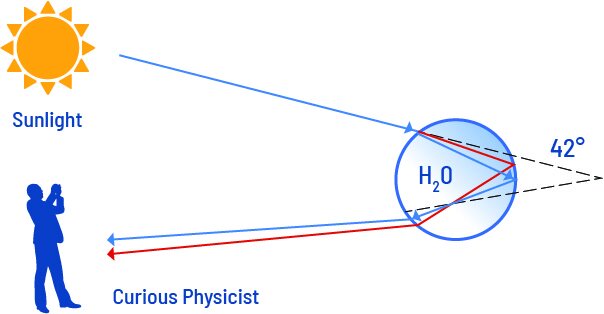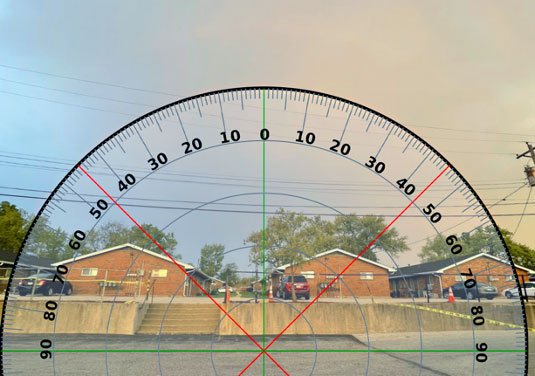By Dr. Matsakis
It's Where You Find It
Rainbows mean a lot of things to a lot of people. In Genesis, the rainbow represents a covenant from God. A promise that the world will never again be destroyed by flood [1]. Rainbows often symbolize a bridge from the ordinary world and the world of the divine, a bridge between God(s) and humans. They can represent an actual stairway to the heaven and, in general, they are symbolic of a power that is bigger than us and outside our control. This power is not always benevolent. The aborigines thought of them as malicious serpents. More romantically, rainbows have been believed to be paths traveled by forbidden-lovers. And of course the Irish will tell you there is a pot of gold at the end, guarded by a Leprechaun. All that is fine, but to a literal-minded scientist like me, when I snapped this picture outside the Masterclock HQ, the interesting part was to find out if the Wisdom of the Ages, i.e. high-school physics, was really correct.
Rainbows, maybe because of their charm, took thousands of years and many brilliant minds to fully understand. Aristotle, for example, speculated that rainbows were caused by light bouncing off water droplets. But he got a few things wrong. For starters, until the Renaissance people thought sight was caused by rays emanating from our eyes interacting with other rays from the light-source [2]. Aristotle noted that the path from the eye to the Sun via the droplets was longer on the outer part of the rainbow than the inner part. And since he also thought that on long distances red vision-rays dominate over blue, he had an explanation for why the red was on the outside of the rainbow [3].
 Beautiful to all, the rainbow even swayed the telephone pole. (Actually a result of optical distortion.)
Beautiful to all, the rainbow even swayed the telephone pole. (Actually a result of optical distortion.)
Shen Kuo and Sun Sikong, in the glory days of the pleasure-loving Song dynasty (my favorite, see [4]) also thought rainbows were caused by sunlight encountering droplets. Descartes experimented with water-filled spheres, and quantitatively determined that light would come out at an angle 42.5 degrees from where it went in. And finally, Newton explained that rainbows were red on outside because red light bends a little less when crossing the air/water barrier [5]. The 42.5 degrees at each side makes the whole rainbow 85 degrees in diameter, centered on the line from the Sun through the eyes of the beholder – which means no two people see exactly the same rainbow.
 Red light is bent slightly less as it enters, and again less as it leaves, so appears on the outer side of the rainbow [6].
Red light is bent slightly less as it enters, and again less as it leaves, so appears on the outer side of the rainbow [6].
Ok, so the full rainbow should cover 85 degrees for red light, which defines its outer edge. But could we prove that from my picture of the rainbow, which wasn’t even a full rainbow? We had to convert inches on a two-dimensional picture to an angle. Worse, there is optical distortion at the edges of the picture – that telephone pole is not about to fall down, as it would appear in my photo. [7].
I thought maybe there was enough information to correct for all that. So I asked our intern Lukas Burzynski if he could take time away from testing the GPS/GNSS receivers that we were preparing to ship to NASA. Lukas eagerly obliged. He googled up a protractor image and superimposed it on the rainbow picture, which told us how much of the rainbow was captured. (Also that it was pretty close to a perfect circle.)
Then we had to figure out exactly where I had been standing. That would be the spot where the poles on the embarkment lined up with the houses and trees in the picture’s background. We found it, but maybe we were a foot off.

We used a tape measure to get the distances of the triangle between the camera spot and the poles at the extreme ends of the embarkment [8]. We also moved one of the NASA-ready GMR5000’s, with its antenna, to each of those spots, and captured the position measurement data on a laptop. The values we got were consistent with the tape measure data, but due to multipath the GMR5000 positions were a little less precise.
With all that data, we could infer the full rainbow angle using the Law of Cosines plus some Euclidian geometry. The uncertainties were a little tricky, but we assigned values of one foot to all the positions, and 2 degrees for the protractor readings. We found the rainbow’s “true outer diameter” was 84.8 degrees, plus or minus 1.2 degrees (2-sigma).
Success!
But what about the gold? Unfortunately, we couldn’t figure out how to measure the distance of the rainbow’s droplets. But the joy of communing with nature was more than enough reward for us.
Footnotes
[1] There is no mention of global warning in the scriptures. But even if the ice caps melt, sea level will only rise about 70 meters (230 feet).
[2] Hence, the “evil eye”. This also explains how the Medusa was able to turn people into stone just by looking at them. For further research, I recommend watching “The Clash of the Titans”. Also, check out your cat’s eyes at night. Evolution has obviously enhanced their ray-emitting power so as to better catch mice, probably through the laser-like lenses long known to philosophers.
[3] He was correct that red light does scatter less, which of course is why the Sun gets red when it is low, and why the sky is blue. Our eyes actually are more sensitive to lower levels of red light than other colors. With apologies to the millennials who may have to google my terminology, that’s why photographers used red lights in darkrooms to develop film.
[4] How could you not like that dynasty? All timekeepers know of the great Chinese water clock (https://en.wikipedia.org/wiki/Su_Song). But that’s far from the only reason. For example, even Robin Hood would have been impressed by the deeds of his Song-dynasty contemporaries, described in The Outlaws of the Marsh. See http://noblebandits.asu.edu/Text/OutlawsMarsh.html. Unfortunately, the party ended when the Mongolians conquered China.
[5] At the St. Louis aquarium there are fish who know how to account for the bending when they spit water out to catch flying insects, or tourists who get too close. As for colors refracting differently, you can check this out at a swimming pool with a colored stick.
[6] Actually, the 42.5° only applies to light that hits the outer part of the water droplet, which is the largest region and therefore catches the most light. We see an edge because no light at all gets thrown back at a larger angle. Light hitting a droplet dead-center gets reflected straight back and would be seen at the center of the rainbow’s circle, and light hitting the droplets further in from their edge gets reflected so it comes inside the rainbow’s arc. Even the ancients noticed that the sky is brighter inside the rainbow than outside. Light that reflects twice inside the rainbow causes a secondary rainbow about 10° farther out. You can get up to 13 of those [6.5]. Light also can be reflected by hexagonal ice crystals, forming halos around the Sun with about 22° radius. I don’t know about Horatio, but there certainly is more to heaven and Earth than is dreamt of in my philosophy!
[6.5] This from Jearl Walker http://optica.machorro.net/Optica/SciAm/Rainbow/1977-07-body.html. If you google him, you will find many interesting things. But you will not yet find that he is the first person to use the terminology “Auger-Meitner” in a textbook. (See my blog, “Lise Meitner: a woman I admire” https://www.masterclock.com/company/masterclock-inc-blog/meitner)
[7] It turns out Apple knows about the camera distortion. It’s an engineering compromise. You can find out how to reduce it here: https://support.apple.com/en-us/HT210571
[8] While making the measurements, a car barreled down the street and split the tape in two. Was a Leprechaun driving it?
About Dr. Demetrios Matsakis
 Dr. Demetrios Matsakis attended MIT as an undergraduate and received his PhD in physics from UC Berkeley, where he studied under the inventor of the maser and laser; and built specialized ones in order to observe interstellar dust clouds where stars are born. His first job was at the U.S. Naval Observatory, building water vapor radiometers and doing interferometry to observe quasars and galaxies at the edge of the observable universe. After developing an interest in clocks, Dr. Matsakis would spend the next 25 years working hands on with most aspects of timekeeping – from clock construction, to running the USNO’s Time Service Department, to international policy. He has published over 150 papers and counting, but gets equal enjoyment out of beta-testing his personal ensemble of Masterclock products.
Dr. Demetrios Matsakis attended MIT as an undergraduate and received his PhD in physics from UC Berkeley, where he studied under the inventor of the maser and laser; and built specialized ones in order to observe interstellar dust clouds where stars are born. His first job was at the U.S. Naval Observatory, building water vapor radiometers and doing interferometry to observe quasars and galaxies at the edge of the observable universe. After developing an interest in clocks, Dr. Matsakis would spend the next 25 years working hands on with most aspects of timekeeping – from clock construction, to running the USNO’s Time Service Department, to international policy. He has published over 150 papers and counting, but gets equal enjoyment out of beta-testing his personal ensemble of Masterclock products.

